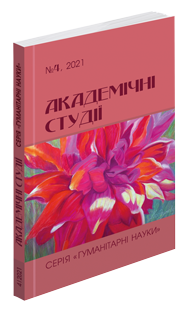Abstract
In this article the main peculiarities of the emotive and lexical-semantic spaces of the literary text are generalized, the main directions of the thematization of emotions in the structure of the British military fiction texts of the beginning of the 21st century are identified, the ways of their functioning are briefly described. The meaning of a word in a literary text does not simply express a certain realia of the world, it renders various additional shades reflecting the peculiarities of the original author’s thought and world perception as well.
Certainly, first of all the fiction texts with the elements of military themes are characterized by rendering of the negative range of emotions and feelings, which to a bigger or less extent are caused by the war and military actions. In general the following dominant directions of the thematization of emotions can be outlined in the structure of the contemporary British military fiction texts: the use of the thematic vocabulary signifying feelings and emotional experience of a person; lexical units and combinations with a special emotional-expressive shades of meaning; evaluation of the emotional state of the characters (which can be expressed either by other characters or by the author him- / herself); identifying of the emotional state through the context.
Thus, the lexical-thematic units which altogether compose the emotive space of the literary text are supposed to serve special functions in the military fiction texts. Precise descriptions of the psychological and emotional state of the characters, their expressive reinforcing in the texts makes the reader closer to the fictitious world, helps him / her feel as a participant of the events and experience the same things the characters do. The reader takes an active part in the actions and feels as if he / she is immersed in the scary reality of the war / post-war world. The authors depict the feelings of the characters to the tiniest details – their sorrow, pain and frustration as the result of the military actions. All this enables creating of the maximally realistic picture of the war reality, rendering the power and perniciousness of the war.
References
Бехта І.А. Дискурс наратора в англомовній прозі: монографія. Київ: Грамота, 2004. 304 с.
Гамзюк М.В. Емотивний компонент значення у процесі створення фразеологічних одиниць (на матеріалі німецької мови): монографія. Київ: Вид. центр КНЛУ, 2000. 256 с.
Романова Н.В. Емотивна лексика у мові «творів про техніку» Бернгарда Келлерманна. Літературний процес: методологія, імена, тенденції. 2013. № 2. С. 26–32.
Шайнер І.І. Лексико-семантичний простір британських художніх прозових текстів на військову тематику: прагмастилістичний аспект : автореф. дис. на здобуття наук. ступеня канд. філ. наук: спец. 10.02.04 «германські мови». Херсон, 2019. 20 с.
Atkinson K. Life After Life: ebook. 2016. 776 p.
Barlow A. The Great War in British Literature: Cambridge Contexts in Literature. Cambridge, 2000. 130 p.
Bergonzi B. Wartime and Aftermath: English Literature and the Background 1939–60. Oxford, 1993. 230 p.
Black E. Pragmatic Stylistics. Edinburgh, 2006. 166 p.
Boyne J. The Absolutist: ebook. 2011. 497 p.
Boyne J. The Boy at the Top of the Mountain: ebook. 2015. 309 p.
Cobley E. Postmodernist War Fiction: Findley’s The Wars. Canadian Literature. 1995. № 147. Р. 98–124.
Gee J.P. How to Do Discourse Analysis. New York, 2010. 206 p.
Harris J. Five Quarters of the Orange: ebook. 2001. 522 p.
Ho Y. Corpus Stylistics in Principles and Practice. London, 2011. 254 p.
Hogan P.C. Stylistics, Emotion and Neuroscience. The Routledge Handbook of Stylistics / ed. by M. Burke. London; New York: Routledge, 2014. P. 516–530.
Lakoff G. The Contemporary Theory of Metaphor: Metaphor and Thought. Cambridge, 1993. 245 p.
Lyons J. Semantics (1). Cambridge: Cambridge University Press. 1997. 371p.
Piette A. Imagination at War: British Fiction and Poetry, 1939–1945. London: Papermac, 1995. 352 p.
Salkie R. Text and Discourse Analysis. London: Routledge, 2001. 115 p.
Sarma G. The War Novel: Hemingway and After: thesis for the degree of PhD. Shillong, 2001. 223 p.
Shen D. Stylistics and Narratology. The Routledge Handbook of Stylistics / ed. by M. Burke. London; New York: Routledge, 2014. P. 191–205.
Simon-Vandenbergen A.-M., Aijmer K. The Semantic Field of Modal Certainty: A Corpus-Based Study of English Adverbs. Berlin, 2008. 405 p.
Smith A.K. The Second Battlefield: Women, Modernism and the First World War. Manchester, 2000. 214 p.
Stockwell P. The Texture of Authorial Intention. World Building: Discourse in the mind / ed. by G. Gavins, E. Lahey. London, 2016. P. 147–163.
Toolan M. Language in Literature: An Introduction to Stylistics. New York, 2013. 250 p.
Widdowson H.G. Text, Context, Pretext. Blackwell, 2004. 185 p.

